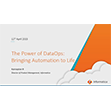
Google Cloud Targets Scientific Innovation with H4D VMs and AI-Powered Research Tools
LAS VEGAS, April 11, 2025 — Significant advancements in computing power have fundamentally reshaped the scientific process. Computational tools now enhance both theoretical and experimental workflows, driving discoveries across scientific disciplines through numerical simulations and data analysis.
Google Cloud’s ongoing investments in foundational research, scalable infrastructure, and artificial intelligence continue to support and accelerate scientific progress. These efforts have contributed to advances in drug discovery, weather forecasting, and materials design, alongside high-performance infrastructure, cloud-scale software tools, and powerful generative AI models and assistants.
Now, the combined capabilities of Google DeepMind, Google Research, and Google Cloud infrastructure are being brought together to accelerate global scientific discovery, with the goal of making Google Cloud the most capable platform for research and innovation.
This week, Google Cloud announced new supercomputing-class infrastructure and its first AI-powered science applications, further advancing this mission and enabling a new wave of scientific breakthroughs.
Supercomputing Infrastructure Solutions for Complex Scientific Challenges
Scientists use supercomputers to tackle the world’s most challenging compute- and data-intensive problems. Supercomputers are systems such as high performance computing (HPC) clusters that utilize powerful CPUs and often GPUs, like our recently announced A4 and A4X VMs.
These resources deliver the massive performance needed for large-scale simulation, data analysis, and AI model training. Simplified access to supercomputing-class resources, HPC cluster software, and AI tools and applications has become vital for scientific discovery and AI innovation.
To meet these needs, Google Cloud has introduced H4D VMs, its most powerful CPU-based virtual machines to date. Built with the latest AMD CPUs and advanced Titanium network acceleration, H4D VMs are designed to support supercomputing-class HPC clusters that can scale applications across thousands of processors. These systems enable faster and more accurate solutions to complex scientific problems. H4D VMs with Titanium networking are now available in preview.
“This leap in computational capability will dramatically accelerate our pursuit of breakthrough therapeutics,” said Petros Koumoutsakos at Harvard University, “bringing us closer to effective precision therapies for blood vessel damage in heart disease.”
To simplify the deployment and management of complex clusters, Google Cloud also announced Cluster Toolkit, which enables repeatable and reliable cluster deployments. When used with Cluster Director (formerly Hypercompute Cluster), researchers can deploy and manage large clusters as unified systems, improving performance, efficiency, and resilience.
In response to the extreme storage demands of scientific and AI workloads, Google Cloud introduced Google Cloud Managed Lustre, a high-performance, fully managed parallel file system built in collaboration with DDN and based on EXAScaler Lustre.
AI Models for Science, Powered by Google
Google Cloud infrastructure not only enables complex simulations but also powers advanced AI models that accelerate scientific discovery. Google Cloud this week announced its first AI-powered science applications.
AlphaFold 3, developed by Google DeepMind and Isomorphic Labs, can predict the structure and interactions of all of life’s molecules with unprecedented accuracy. The new AlphaFold 3 High-Throughput Solution, available for non-commercial use and deployable via Google Cloud Cluster Toolkit, enables efficient batch processing of up to tens of thousands of sequences while minimizing cost through autoscaling infrastructure.
“Having access to AlphaFold on Google Cloud can help our researchers rapidly predict and explore the structure and interactions of all biomolecule classes, accelerating our understanding of diseases,” said Sumaiya Iqbal from Broad Institute Ladders to Cures.
WeatherNext AI models, from Google DeepMind and Google Research, provide fast, accurate weather forecasting. Google Cloud is making these models available through Vertex AI Model Garden, enabling users to customize and deploy them for research and industry use. These tools support expanded scenario modeling and improved preparedness for weather-related impacts.
Quicker Ideas for Faster Scientific Discovery
Google Cloud also introduced two new AI agents within Agentspace, designed to help accelerate scientific progress by rapidly generating new research hypotheses.
The Deep Research agent condenses hours of research, and can synthesize external and enterprise data to generate in-depth research reports; while the Idea Generation agent can help rapidly develop novel ideas and hypotheses for scientists to test. Both agents are available in preview.
Advancing Scientific Innovation
Scientific discovery continues to shape understanding of the universe, address global challenges, and drive innovation across sectors. With these announcements, Google Cloud expands its commitment to equipping scientists and researchers with the advanced tools and infrastructure needed to push the boundaries of discovery.
Scientists and researchers can get started right away with credits, training, and more via Google Cloud for Researchers. All who are interested in HPC, AI, and other advanced computing technologies are welcome to join the Google Cloud Advanced Computing Community to learn more about how the latest technologies in Google Cloud can help advance scientific research and discovery.
Source: Pushmeet Kohli and Partha Ranganathan, Google Cloud




























